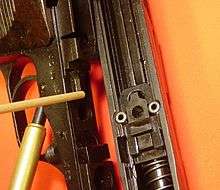Roller locked
In firearms operating systems, the term roller locked refers to locking the bolt with rollers. Notable examples of firearms using this method are the MG42 and Rheinmetall MG3 machineguns, and the CZ 52 pistol.
Roller-delayed blowback as in the HK G3, where similar rollers are used is sometimes mistakenly called roller locked, but there is no genuine locking of the bolt and no recoiling of the barrel in delayed blowback action.
Roller locking is used by the CZ 52 pistol, slide, barrel, locking piece and rollers shown here. Normally the recoil spring pushes the locking piece rearward, which in turn pushes the barrel back and holds the locking rollers. (In some of these pictures the spring is removed)

When the gun is fired, the barrel, slide and locking piece (right side of picture) will move backwards a short distance, while the locking piece will be stopped by a tab on the frame, shown on the left with a stick pointing out the mating surface.

With the locking piece stopped by the tab, the rollers will continue rearward with the slide, until they reach the recessed portion of the locking piece. The rollers will then be allowed to move inward, and will release from their indentations in the slide releasing the slide from the barrel.

At about the same time, the barrel will be stopped by the locking piece. Momentum will carry the slide back against the pressure of the recoil spring where extraction and feeding a fresh cartridge happen similarly to other designs.

As the slide moves forward, the locking piece maintains outward pressure on the rollers. When the recesses in the slide are positioned with the rollers, the locking piece will push them out into the recesses and move forward, locking the barrel to the slide again, the barrel and slide will move forward a small amount and stop. prepared for another cycle. Unlike a standard Browning short-recoil action, there is no tipping of the barrel during operation.